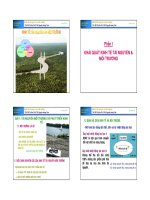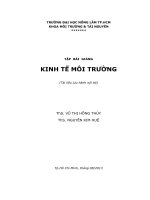Bài tập kinh tế môi trường
Bạn đang xem bản rút gọn của tài liệu. Xem và tải ngay bản đầy đủ của tài liệu tại đây (94.58 KB, 2 trang )
Extraction Path
Ex.1. Draw the demand curve of your amount of copied pages per year and demand curve of
your group’s amount of copied pages per year.
Ex.2. Recently a large cave with about 200.000 tons of guano was rediscovered in northeastern Zimbabwe (this is true). Suppose that the government wishes to dig up and sell
the guano over a period of three years, and that it faces the following demand
functions:
In year 1
In year 2
In year 3
Qd = 161.000 – 100 P
Qd = 180.000 – 100 P
Qd = 190.000 – 100 P
The marginal extraction cost is $200/ton, the interest rate is 10%, and there is a fixed, up-front
cost (access roads, drying plinths, etc.) of $40 million.
a. How much guano should be mined in each year (the “optimal extraction path”)?
b. Is this proposed project profitable? Explain, by setting up the cost-benefit analysis.
c. How would the answer to a. be changed if the deposit has only 150.000 tons?
Ex.3. Assume a perfect competitive market; the price for a product (P) is 5.0 million
VND/unit. Pollutant discharged into the environment depends on the amount of
produced product by the equation: T = 0.1Q (where Q is product; T is the amount of
waste in ton). The marginal cost of production is 0.01Q.
•
•
How much the minimum tax rate for each unit of product to control the T ≤ 30
tons?
Comparison of products equivalent to 30 tons of waste with optimal product Q* if
externalities marginal cost is 3Q/700.
Ex.4. Coal and External Costs
a. Suppose that the demand curve for coal is given by Qd = 480 – 2P, the supply curve
by Qs = 10p, and that the industry is competitive. Graph the demand and supply
curves, and find the market price and quantity.
b. Expert estimate that for every ton of coal used, the rest of society has to bear costs of
$15/ton (= “marginal external costs”). So the government puts a $15/ton tax coal.
Draw the new supply curve, and show and find the price which consumers of coal will
now have to pay, and the quantity produced.
c. Briefly comment on the pros and cons of using each of the following to deal with
pollution caused by using coal:
i) Taxing the output of coal
ii) Taxing the pollution caused by using coal
iii) Regulating/limiting the output of coal-generated pollution directly.
Ex.5. Forests
1
a. You plant a tree which grows 50% in the first year, 49% in the second year, and so on
– i.e. it grown 1% less quickly in each succeeding year. The real interest rate you face
is 6%. When should you cut the tree? Explain.
b. You are interested in harvesting trees from a 15 square kilometer area of tropical
forest. Two types of trees are worth cutting; species A trees can be sold for $100/cubic
meter and species B for $70/cubic meter. There are 2000 stems of species A and 5000
of species B which are potentially worth harvesting; the rest of the forest will be left
more or less intact, so this level or harvesting is considered sustainable. Your overhead
fixed costs are $ 80.000 (to build a logging road, buy some equipment, etc.); it then
costs $50 per cubic meter harvested.
i) What is the maximum amount you would pay for permission to work this
concession (i.e. what is the rent generated by this forest)?
ii) How much tax revenue would the government get if it put a tax of 30% on the
selling price of the wood? (Assume you cannot sell the wood for more than $100
and $70 respectively). Explain.
iii) How much tax revenue would the government get from a 45% tax on the profits of
the company? Is this a better or a worse tax than the tax in part ii)? why?
2









